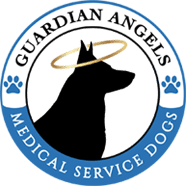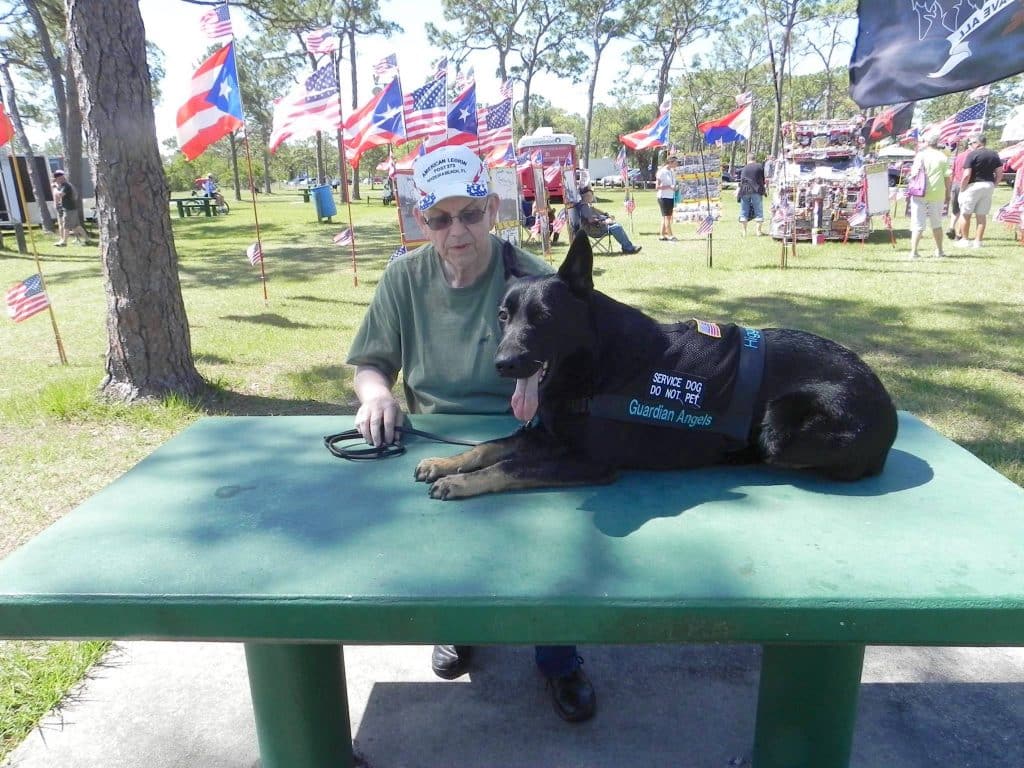Our dogs are an important part of our lives. Whether they are a pet or a service dog, keeping them at a healthy weight is crucial for a long and happy life. When it comes to a dog being overweight, there are a wide variety of risks that rise in numbers and severity with increasing weight to the point that pet obesity is now categorized as a disease in companion animals as it is in humans.
Learn more about the insights and tips Charlotte Rogers, DVM, the National Veterinary Director at Guardian Angels Medical Service Dogs, has on weight management and the new respiratory disease in dogs.
The Health Risks for Overweight Dogs
It comes as no surprise that obesity is bad for health both in humans and animals. Fat tissue contains a high concentration of various pro-inflammatory cells, which essentially means the more fat tissue is located in and around the body, the more generalized inflammatory cascades occur. This leads to a variety of issues, such as:
An increased risk of cancer
- Arthritis
- Ligament/tendon damage
- Cardiovascular disease
- Diabetes
- Decreased immune function
- Kidney/liver damage
In addition to these issues, there are many other health risks that reduce the quality and longevity of your dog’s life when they are overweight.
The first ever lifelong canine diet restriction study, conducted by Purina Pet Care, scientifically proved that a dog’s median lifespan can be extended by 15% (or around 2-3 years) simply by making sure these dogs maintained a healthy ideal body condition in their lifetime and did not become overweight for an extended period.
Determining If Your Pet is at a Healthy Weight
Owner’s views on their pet’s ideal weight status can be very subjective, and perceptions have changed dramatically over the years. Unfortunately, the media, certain pet food companies, and the increasing availability of people posting their own opinions online under the guise of “expert advice” do not make it easy for the average pet owner to get the proper education on the ideal weight for their own pet.
Making sure your dog is of healthy weight is a two-fold approach. It is important to know your dog’s current actual weight, which can be obtained on a scale at your local veterinary clinic (most clinics will gladly allow you to bring your pet in for a weight check without the concurrent need and cost for a full exam) or, if you are able to train your dog to sit on a bathroom scale you can do it yourself at home.
While weighing your dog can be helpful, being able to determine your dog’s ideal body condition status cannot rely on a scale measurement alone since numbers will vary with age/breed/muscle condition, etc. So, understanding how to perform a body condition score (the animal version of a BMI) and combining this with the actual weight of your pet is key. It is a subjective measure of your dog’s body fat, and your veterinarian can guide you with the specifics. We’ve gathered a few verified online sources to help you learn more about the body condition score:
- https://www.icam-coalition.org/tool/dog-body-condition-scoring-training/
- https://vcahospitals.com/know-your-pet/body-condition-scores
- https://www.purinainstitute.com/centresquare/nutritional-and-clinical-assessment-tools
Maintaining a visible waistline is important for dogs. When you touch their ribs, you should be able to feel them, not a layer of fat. If you can’t feel their ribs, it may indicate that your dog is overweight. You can get a general idea if they are overweight or not by simply looking down over their back and checking for an indentation between the ribs and hips. If this area goes straight back without an indentation or balloons out, your dog is likely overweight.
It is always important to consult with your veterinarian first if you think your dog is overweight before making any major changes to their diet or lifestyle.
How Much Exercise Does Your Dog Need?
The duration, frequency, and intensity of your dog’s exercise needs will vary, but a good general rule of thumb for an adult large-breed dog, such as a German Shepherd, is to reach a goal of around two hours of exercise each day. When this is recommended, it doesn’t mean a consistent two hours of a high-intensity workout, like running or other extreme physical activity, but there should be a percentage of the two hours dedicated to something that will require higher energy demands. This can include things such as long walks, play sessions, training sessions, etc.
How Often, How Much, and What Food Should You Feed Your Dog?
An adult dog can generally be fed once a day if there are no medical or behavioral reasons not to. However, with deep-chested large breed dogs, it is encouraged to feed meals more frequently to lower the volume of food they ingest in their stomach each time. This helps to decrease the chances of GI disturbances such as bloat, GDV (twisted stomach). Dividing the total amount of daily food requirements into 2-3 meals is typically recommended.
The general recommended amount your dog needs to be fed each day will vary based on your dog’s needs and the specific diet you are feeding them. A detailed daily calorie calculation for the energy demands of your dog can be calculated and advised by your veterinarian, a qualified pet nutritionist, or a seasoned trainer.
A general range for the maintenance energy requirement (total amount of kcal/day) for a 75lb indoor dog is 790-2400 kcal/day. If you are feeding a diet that contains 500kcal/cup this means feeding 1.5 to 5 cups TOTAL per day. Using an actual measuring cup (rather than a solo cup/grandma’s favorite coffee mug, etc.) when feeding your dog is vital to ensure they are getting an accurate portion each time.
Despite many marketing claims, there is no one specific best pet food to feed pets across the board. Cost doesn’t always equal quality, and label claims are not always valid. The minimum criteria to follow for dog food selection guidelines from WSAVA, the largest worldwide collaborative group of veterinary and animal welfare individuals, on picking a pet food are as follows:
- Select food that is made by a responsible company.
- Selecting a food that is quality control tested.
- Evaluating the label for AAFCO statements that are appropriate.
- Asking what product research has been done and how that information is made available.
If you’re unsure of what to feed your dog, it is best to work with your veterinarian to find the best options.
If you are a recipient of one of our service dogs and have questions about food, exercise, or other health concerns for your service dog, contact Guardian Angels Medical Service Dogs today to learn more.
New Respiratory Disease in Dogs: What You Need to Know to Keep Your Dog Safe
While there are real impacts of the “mystery dog respiratory disease” that have been occurring in the nation, it’s important to consider that this may or may not be the major outbreak it’s been getting the attention for. There are certainly cases of canine infectious respiratory disease complex (CIRDC) that have occurred that don’t follow the normal pattern of clinical signs or response to treatments, but it is important to separate general hype within the media from facts to keep your dog safe and healthy.
Reports of atypical kennel cough/flu/respiratory diseases in dogs have occurred in many states across the nation recently, but no singular, contagious new or old pathogen has been identified. Multiple laboratories around the country are still testing continuously to detect a primary cause. Unfortunately, we still do not have many “facts” about this issue since there is no coordinated surveillance for all dog respiratory diseases, so information needs to come from a variety of sources.
It is the time of year when there is a predictable increase in respiratory disease in general for dogs (and people) for regular respiratory diseases such as flu/kennel cough, etc. Potentially, this “new disease” is a combination of the regular respiratory diseases that are occurring more frequently than normal with additional local outbreaks.
It could still be a new disease or a mutation of a previously known pathogen. Regardless, it is always best to report to your local veterinarian immediately if you have any suspicion of abnormal respiratory signs. CIRDC signs include:
- A “honking” cough that may sound like retching.
- Sneezing and discharge from the eyes and or nose
- Lethargy, decreased appetite, and labored breathing.
It’s important to remember that not all dogs show all these signs, and each case can be slightly different.
What to Do If You Think Your Dog Is Sick
First and most importantly, take a deep breath. There is a lot of media hype and misinformation circulating regarding the recent “mystery respiratory” illness in dogs, but there is no reason to panic.
If you are concerned or have specific questions relating to your individual dog, the best person to contact is your dog’s regular veterinarian, who knows the internal and external health status of your dog the best.
For our service dog recipients, if your regular veterinarian has, in fact, determined that your service dog is suffering from any significant respiratory illness, you can contact Guardian Angels Medical Service Dogs for any further guidelines. Many of you update our veterinarian staff frequently with any health concerns with your dog or significant medical issues, which is great for us to be able to offer our remote guidance when applicable.
How is this Disease Treated?
General canine infectious respiratory diseases are treated in a variety of ways depending on the suspected cause and clinical signs of your dog. This can be as minimal as providing medications used to directly treat mild symptoms, such as an anti-tussive for a cough and keeping your dog away from interactions with other dogs. On the other end of the spectrum, a dog may need to be hospitalized to treat their clinical signs and provide lifesaving care such as IV medications and nutrition.
At this point in time, a specific “new” respiratory pathogen/disease has not been found, but there have been reports of a select number of dogs not responding to some first-line medical therapy generally given to treat complex respiratory cases. These cases continue the request for veterinarians nationwide to report any abnormal respiratory clinical signs in dogs, especially those from vaccinated individuals who do not respond to regular medications.
Is This Disease Fatal to Dogs?
Anytime a pet does not respond, as veterinarians would generally predict, to therapy or if a pet is severely affected or immunocompromised for any reason, fatality is always a concern. With this specific topic and inconclusive primary pathogen causes, it is difficult to advise on the likelihood of fatality. There will always be a chance of death in any disease process, and this can increase depending on the underlying cause and the overall health status of your dog.
Are There Any Lasting Effects of This Disease?
Lasting effects can occur with dogs who undergo a severe respiratory illness, such as scarring of the lungs, destruction of the gut lining, and organ damage, or they may overcome it with no lasting effects. This is all dependent on the severity of the disease and the overall health status of each individual dog. Just as humans who suffer from a respiratory disease that can be caused by a certain pathogen (such as a virus) and complicated by secondary pathogens (such as bacteria), many of us will show various long-term residual effects.
Tips for Preventing Respiratory Illness in Dogs
Think about your dog’s exposure levels and risk or susceptibility to diseases. As always, contact your dog’s regular veterinarian for individual cases, but general guidelines to follow to prevent exposure to a respiratory disease that is still undergoing intense investigation are as follows:
- Limit your dog’s contacts, especially traveling family or friends with dogs of unknown health status.
- Keep your dog away from sick dogs.
- If your dog is sick, keep it away from other dogs.
- Talk to your vet about vaccination against causes of CIRDC, including canine parainfluenza (CPIV), Bordetella bronchiseptica, and canine influenza (which is more sporadic and vaccine availability is still an issue).
If you are a recipient of one of our service dogs and have questions about this respiratory disease or other health concerns for your service dog, contact Guardian Angels Medical Service Dogs today to learn more.
- Guardian Angels Medical Service Dogs, Bully Max, and Pittsburgh Pirates Team Up - April 26, 2024
- How to Take Advantage of the CTU Patriot Scholarship - April 5, 2024
- Benefits of Service Dogs for Veterans - April 3, 2024





